Influence of Varying Concenterations of Ammonium Sulphate Foliar Spray on Phenology and Yield of Canola - Juniper Publishers
Juniper Publishers-Open Access Journal of Environmental Sciences & Natural Resources
Influence of Varying Concenterations of Ammonium Sulphate Foliar Spray on Phenology and Yield of Canola
Authored by Muhammad Mehran Anjum
Abstract
There is usually a positive yield response when sulfur (S) is applied to rapeseed (BrassicarapaL.) plants grown on S-deficient soils. Canola, being a conventional oil seed and winter season crop that is grown successfully in Pakistan. Research was conducted to study "phonological traits of canola in response to different concentrations of ammonium sulphate foliar spray” at Agronomy Res. Farm, University of Agriculture, Peshawar in season 2014-2015. The experiment consists of ammonium sulphate foliar spray concentrations (1%, 0. 2% and 0.3%) and control means water spray in randomized complete block design replicated four times. Results showed that Number of leaves and number of branches were non-significant while the rest phonological traits were affected significantly. Less days to flowering (303), Days to pod formation (350), Days to maturity (469), and more biological yield (3856 kg ha-1) and grain yield (2360 kg ha-1) were recorded for 1% foliar application of sulphur. While maximum data were recorded in plots with no foliar spray for (days to flowering, days to pod formation and days to maturity) and less biological and grain yield. Data revealed that foliar application of ammonium sulphate at rate of 1% S was more efficient as compared with control for the phenologocal traits of canola. From this study, it was concluded that phonological traits were substantially improved by the foliar application of Sulphur @1%.
Keywords: Canola; Amonium Sulphate; Foliar Spray; Phenological Traits, Yield
Introduction
Rapeseed (Brassica napus L) belongs to the Cruciferae family the common species are Nigra, Carinata, juncea, oleracea and compestries [1]. Rapeseed or mustard was grown from 300Bc in Indus valley of Pakistan as a fodder crop. Rapeseed and mustard are traditional oil seed crops of Pakistan are grown in large area of four provinces of country [2,3]. Canola was introduced in Pakistan during 1995 for general cultivation to replace traditional oilseed crops like rapes and mustards because of its low erucic acid contents and high yielding capacity. During 2011-12 in Pakistan tha Canola crop was cultivated 14700 ha with the production of 7000 tones, while Khyber Phukhtunkhwa the area under cultivation was 1300 ha with a total production of 1800 tones [4,5]. Like all other crops, growth, developmental process and grain yield of canola depends upon biotic and abiotic factors. Sulfur is the fourth major plant nutrient after nitrogen, phosphorus and potassium. It is essential for synthesis of the amino acids like cystine, and methionine, a component of vitamin A and activates certain enzyme systems in plants [6]. It is also an important soil fertility factor to consider when growing canola [7,8] because of high requirement of S by Cruciferae family [9]. The seed yield, total dry matter and harvest index in some genotypes of Brassica napus and Brassica juncea has been found to improve with higher rate of sulphur [10,11]. Sulphur deficiency adversely reduces yield, protein and enzyme synthesis [9]. Sometimes Plant immobility makes the nutrient deficient and S deficiency at any growth stage can cause considerable reduction in seed yield of canola and thus a regular supply of available S is required throughout the growing season [12]. Plant nutrients availability at appropriate time and amount is predictable to harvest optimal yields. Soil fertility status varies with nature of cropping pattern and management practices. In Pakistan, entire available soil is almost nutrient deficient [13]. Soils are generally deficient in organic matter content reflecting the severe deficiency of nitrogen (almost 100 %) with phosphorus deficiency in more than 90 percent soils and potassium in 50 percent soils [14]. Micronutrients; zinc, boron and iron are also emerging as deficient [15]. Ahmad and Khan [16] declared that 75-92 percent soils of Pakistan are deficient in organic matter (0-1%), 70-95 percent in phosphates and 20-60 percent soils in potash. Keep in view the importance of ammonium sulphate present research was conducted in order to study the response of canola to different application of foliar spray on canola the objectives to determine the effects of ammonium sulphate (1%, 0.2%, and 0.3% ) foliar application on canola phenology and traits.
Materials and Methods
The Experiment entitled "Phenological traits of canola in response to different concenterations of ammonium sulphate foliar spray" was conducted at the Palatoo research farm Department of Agronomy, Amir Muhmmad khan Campus, Mardan during rabi season 2014-2015. The experiment consists of ammonium sulphate levels (1%, 0. 2% and 0.3%) and water spray. The experiment was laid out in randomized complete block, having four replications. The plot size was 2x2 m2. Ploughing was done with help of cultivator and crop sown. The basel dose N and P @70 and 40kg1 ha applied respectively. Hoeing was carried out after rosette stage to control weeds. All the agronomic practices were applied according to crop need.
Statistical Analysis
data recorded was analyzed statistically using analysis of variance techniques appropriate for randomized complete block design (Table 1). Means were compared using LSD test at 0.05 level of probability, when the F-values were significant [17,18].

Result and Discussion
Number of Leaves Plant-1
Data regarding number of leaves as influenced by different levels of Ammonium Sulfate foliar spray is presented in Figure 1. Statistical analysis of the data had showed non-significant effect. However, the number of leaves generally increased with the increasing levels of Ammonium sulfate as foliar spray. The possible reason might be that it is genetically character which cannot be effected by external application of fertilization/ nutrients respectively. As the ammonium sulphate solution was applied to crop in very less concentration, therefore the number of leaves was not significantly affected.

Number of Branches Plant-1
Number of branches per plant as influenced by different levels of Ammonium Sulfate foliar spray is presented in Figure 2. Analysis of the data had showed non-significant effect on branches per plant. However, the number of branches generally increased with the increasing levels of Ammonium sulfate as foliar spray. The possible reason might be that it is genetically character which cannot be effected by external application of fertilization/ nutrients respectively. As the ammonium sulphate solution was applied to crop in very less concentration, therefore the numbers of branches were not significantly affected.
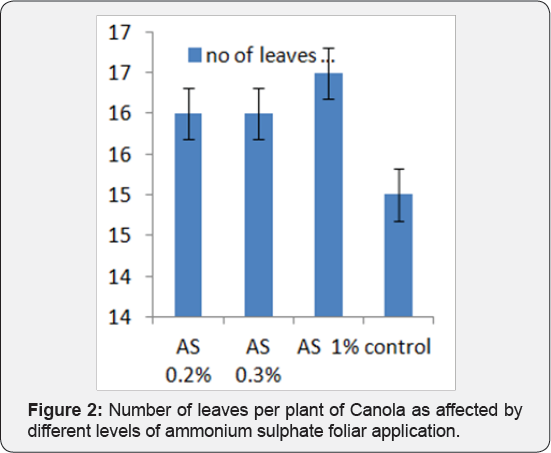
Days to Flowering
Data regarding days to flowering as influenced by different levels of Ammonium Sulfate foliar spray is presented in Figure 3. Statistical Analysis of the data had showed significant effect on number of days taken to initiation of flowers formation. Maximum days to flower formation initiation (303) were noticed by the application of 1 % foliar application of Ammonium sulfate, followed by 0.3 % foliar spray (308) while minimum days to flowering (309) was recorded in plots with no spray. These findings are also in line with Brandt et al. [5].
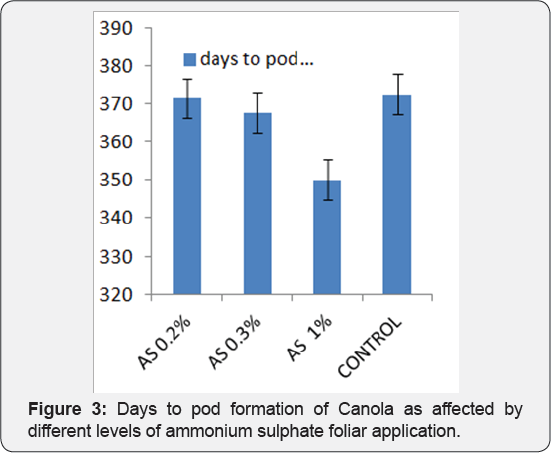
Days to Pods Formation
Pods formation of canola as influenced by different levels of Ammonium Sulfate foliar spray is presented in Figure 4. Statistical Analysis of the data had showed significant effect on number of days taken to pods formation. Maximum days to pods formation (350) were recorded by the application of 1 % foliar application of Ammonium sulfate, followed by 0.3 % (367), 0.2 % (371) while minimum days (372) were recorded in plots with no spray. These findings are also in line with Brandt et al. [19].
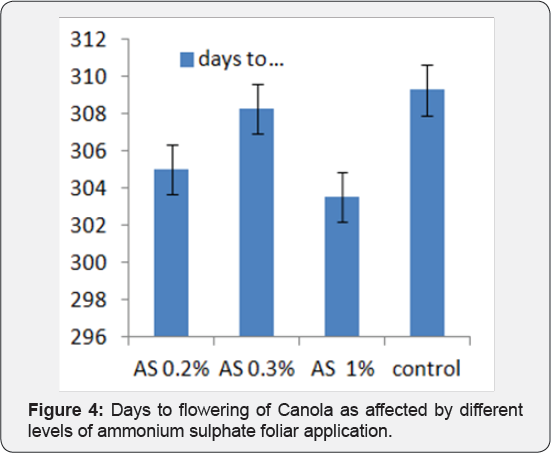
Days to Maturity
Number of days taken from sowing till the maturity of the crop as affected by different levels of Ammonium Sulfate foliar spray is given in Figure 5. Based on statistical analysis of the data showed a significant effect on number of days taken to crop maturity. Maximum days to maturity (469) were observed for 1 % foliar application of Ammonium sulfate, followed by 0.3 % (471) which is statistically at par with 0.2 % spray while minimum days to maturity (484) were recorded in plots with no spray. These findings are also in line with [20,21].
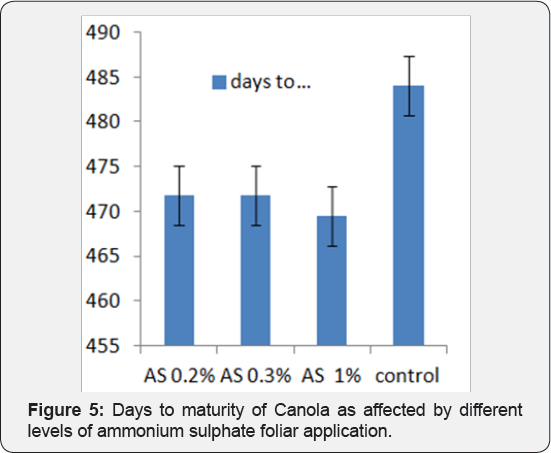
Biological Yield (kg ha-1)
Data regarding on biological yield is presented in Figure 6. Statistical analysis shows that there is a significant effect on biological yield of canola due to ammonium sulphate foliar application [22-24]. Maximum biological yield (3856 kgha-1) were obtained with the application of 1% ammonium sulphate as compare to control(2726 kgha-1), 0.2% (1568 kgha-1) and 0.3%(3233 kgha-1) solution. The results are in line with the findings of Malik et al. [18] and Jan et al. [23] and Sattar et al. [24] who found that from higher rate of sulphur application more biological yield can be obtained.
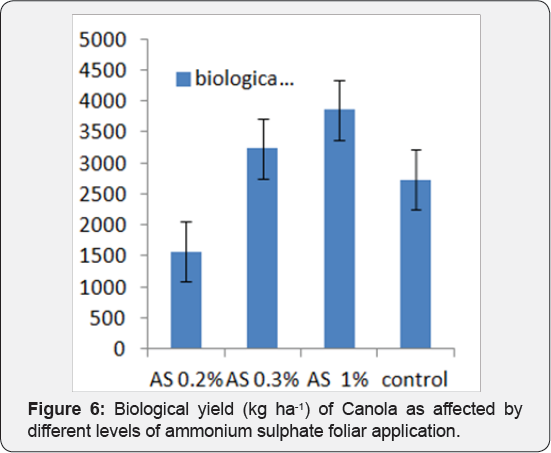
Grain Yield (kg ha-1)
Grain yield kg ha-1 of canola as affected by ammonium sulfate foliar spray is presented in Figure 7. Statistical analysis shows that there is a significant affect in grain yield due to ammonium sulphate foliar application on canola. More grain yield (2360 kgha-1) were obtained with the application of 1% ammonium sulphate as compare to control (2147 kgha-1), 0.2% (1700 kgha-1) and 0.3% (2323 kgha-1) solution. The result is also in agreement with the findings of Sharifi [25] who reported that increasing levels of sulphur solution increased grains yield of canola which is an oil seed crop, respond positively to sulphur application due to which its grain yield increases [26-29].
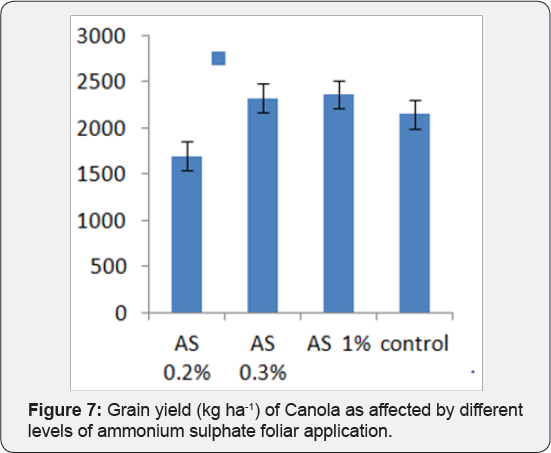
Conclusion and Recommendation
From this experiment it was concluded that number of leaves and branches were not affected by ammonium sulphate foliar spray while less days to flowering (303), days to pod formation (350), days to maturity (469), more biological yield (3856 kg ha-1) and grain yield (2360 kg ha-1) were recorded for 1% foliar application of sulphur. On the basis of current research it is recommended that ammonium sulphate @ 1% foliar spray is optimum for achieving phenological attributes and yield of canola.
To know more about Juniper Publishers please click on: https://juniperpublishers.com/manuscript-guidelines.php
For more articles in Open Access Journal of Environmental Sciences & Natural Resources please click on: https://juniperpublishers.com/ijesnr/index.php




Comments
Post a Comment